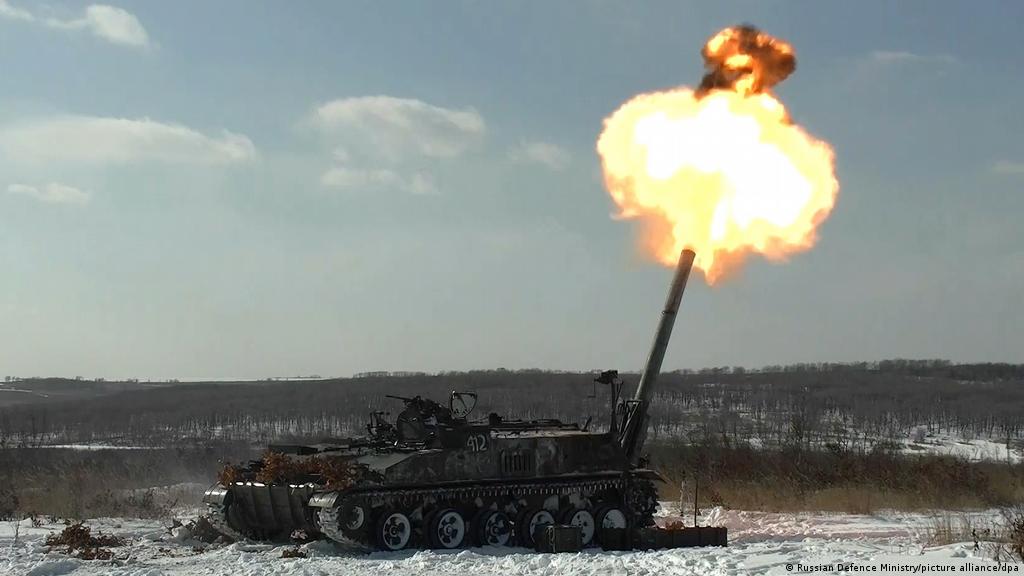China tested its new vehicle-mounted howitzer during a live-fire drill in the Gobi Desert, the state-owned CGTN reported on July 5. The latest howitzer test is essential, considering the renewed importance of artillery due to the ongoing Ukraine War that has led even the US Army to prioritize long-range fire capability.
Russia ‘Smokescreens’ $3.7B Kerch Bridge As US Says Ukraine Can Strike Europe’s Longest Bridge
During the drill, the new howitzer fired long-range shells at targets more than 30 kilometers away to test target efficiency at extreme distances.
The CGTN report said that the new howitzer has a high level of digitization and a new control system that allows for one-click firing. The report did not mention which howitzer was used.
Furthermore, the new howitzer is said to have semi-automatic loading and automatic adjustment, greatly reducing response times.
The latest howitzer test by the PLA comes as China’s closest ally, Russia, is engaged in the ongoing war in Ukraine, where the Russian military continues to make gains on the back of massive deployment of its artillery guns that continue to pound the Ukrainian positions.
The Artillery Duel In East Ukraine
The Russia-Ukraine war is currently centered in the Donbas region of east Ukraine, where both armies have brought to bear their arsenal of long-range artillery guns, comprising Soviet-era and some homegrown systems, and Western-made howitzers in the case of Ukrainian forces.
However, considering the steady gains made by the Russian military in recent months, Russia appears to be winning the artillery duel.
It is potentially because of the unique approach of the Russian military when it comes to employing artillery on the battlefield, where artillery is used as the primary combat arm. It goes against the convention of artillery as a combat support arm for ground forces engaging in ‘maneuver warfare’ or ‘fluid’ warfare.
As per a recent EurAsian Times report, it involves the Russian ground troops supporting the artillery by pushing the enemy forces into kill zones before calling in artillery strikes on them.

The success of the Russian military in effectively using the artillery to ensure decisive victory has renewed the importance of ‘land domain’ in modern warfare and highlighted the need for long-range fire capability.
Before the Ukraine war, most militaries, especially Western nations, emphasized ‘aerial’ dominance. Likewise, Russia expected to secure the Ukrainian airspace first and then seize the land.
Lessons From The Ukraine War
In the words of UK’s Army Chief, General Patrick Sanders, “The war in Ukraine reminds us of the utility of land power: it takes an army to hold and regain territory and defend the people. It takes an army to deter. If this battle came, we would likely be outnumbered at the point of attack and fighting like hell.”
He was speaking at the Royal United Services Institute’s (RUSI) Land Warfare Conference in June, where he explained that standoff air, maritime or cyber fires are not likely to dominate on their own and, therefore, the land will continue to be the strong domain.
The top US army officials made similar remarks during May’s US House Armed Services Committee (HASC) hearing.
The Secretary of the US Army Christine Wormuth and the service’s Chief of Staff General James McConville, when asked by the HASC Chairman to name the systems that will enable the army to win a fight like the one playing out in Ukraine, both the officials quickly answered that Long-Range Precision Fires (LRPF) systems are critical to such a fight.
Artillery Modernization
LRPF is a collective term for long-range artillery and missiles that are currently at the top of the US Army’s list of modernization priorities, which includes four primary systems, the extended-range cannon artillery (ERCA) system; the Lockheed Martin-made Precision Strike Missile; the Typhon mid-range ship killing system that can fire SM-6 and Tomahawk missiles, and the Long-Range Hypersonic Weapon system program, now called Dark Eagle.
The ERCA system, currently known as the XM1299, will improve on the existing 155 mm M109 Paladin series self-propelled howitzers to increase their rate of fire and extend the range, perhaps beyond 64 kilometers.
As discussed earlier by the EurAsian Times, the Paladin can fire only as far as 22 kilometers at a rate of one round per minute, which lags by a wide margin when compared to similar Russian-made systems, for example, the 152 mm 2S35 Koalitsiya-SV that can fire at 40 kilometers (unassisted) at a rate of 9 to 16 rounds per minute.
Similarly, the 155mm M-777 howitzers supplied by the US to Ukraine can also fire only up to 24.7 kilometers with unassisted rounds and 30 kilometers with rocket-assisted rounds, at a rate of 2 rounds per minute for a prolonged time and up to 5 shots per minute in extreme situations.
In comparison, even the Soviet-made 152 mm 2S5 Giatsint-S provides a slightly longer range of 28.4 kilometers for the standard HE-FRAG shell and up to 33 kilometers with a rocket-assisted shell with a maximum rate of fire of 5 to 6 rounds per minute.
Therefore, US Army officials have long emphasized the need for longer-range indirect fire to ensure victory in a potential future great-power conflict with near-peer adversaries like China. The service wants to fight China at extreme ranges in the Pacific.
The war in Ukraine has only reinforced the approach of the US Army, according to General McConville. He said that the Ukraine war has underscored and validated the service’s insistence on re-establishing overmatch against Russia and China’s far-reaching weapons to enable the movement of ground forces on contested battlefields.
- Contact the author at tanmaykadam700@gmail.com
- Follow EurAsian Times on Google News